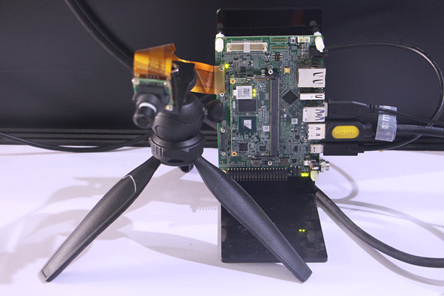In 2021, with the implementation of “new infrastructure” and the promotion of policies such as “carbon peak” and “carbon neutrality”, the entire economy and society will have a deeper understanding of “science and technology are primary productive forces”. As a huge industry that can cover all aspects of B-end production and C-end consumption, the Internet of Things has also ushered in a new opportunity for development.
At the 16th IOTE International Internet of Things Exhibition held from October 23rd to 25th, OFweek went to the booth of Onsemi to visit and exchange, in addition to in-depth understanding of the innovative exhibits brought by Onsemi in this exhibition , and further understand the development and layout of ON Semiconductor in the current industrial market.
Smart sensors drive the rapid development of industrial automation
As a sensing device, a sensor can acquire and detect information, and is the technical basis for automatic detection and system control. Some information and data need to be obtained in the daily scientific research and production process, and all of them need to be collected and obtained through sensors. The principle of the sensor is to convert the signal into an electrical signal and an optical signal and transmit it. At present, common types of sensors have been widely used. With the development of industrial automation technology and scenarios, the demand for sensors is also increasing. Intelligent sensors can effectively collect data in various production links and provide timely feedback to the control center. Intervene in abnormal links to ensure the normal progress of industrial production.

At this exhibition, ON Semiconductor brought a variety of sensor solutions such as 2.3 million-pixel CMOS global shutter imaging sensor AR0234CS, 5 million-pixel XGS image sensor, and VGA global shutter imaging sensor. According to Kai Lijun, application manager of the Industrial Consumer Division of ON Semiconductor’s Intelligent Sensing Department, the AR0234CS is the highlight product of this exhibition, with high dynamic range and innovative pixel design, providing 120 frames per second for machine vision cameras and autonomous mobile robots ( fps) for excellent image clarity. AR0234CS has 3.0um global shutter pixels, and the leading global shutter efficiency can minimize motion artifacts. Secondly, the product supports 4Lane MIPI or 10bit parallel interface, as well as I2C serial interface, so that it can realize simple direct data transmission with the back-end platform, reducing development cost and development cycle. In addition, the product can also operate in the temperature range of -40°C to 105°C, which can be deployed under extremely harsh commercial conditions. This product has been mass-produced and is widely used in industrial production line scanning, robot vision and other application scenarios.

ON Semiconductor also exhibited advanced global shutter imaging, XGS series image sensors with high performance, low noise and low power consumption. As can be seen from the solutions demonstrated on site, in the X-Cube reference design based on the XGS 5000, the XGS 5000 is a 5.3 million-pixel (2592 x 2048) CMOS image sensor with a 2/3-inch optical format that supports a maximum 132 frames (fps) readout with 12-bit output at full resolution. The XGS 5000 shares a common design and layout with other members of the XGS family, enabling a single camera design to support multiple resolutions, simplifying and accelerating time-to-market for new camera designs.
It is worth noting that the products brought by ON Semiconductor this time also support 4K resolution sensors, and the products support RGB, MONO, and RGBIR different types of color filter arrays. The low power consumption performance of the product is in the leading position in the industry. Among them, AP1302 ISP is used to support the development of Easy & Short TTM imaging system, which can be applied to 4K high-performance video conferencing, low-power IOT applications, security cameras, smart access control/door locks, etc. In addition, the audience can also preview a 1/8-inch CMOS digital image sensor – ARX383, 2.8um pixels, resolution of 640 x 480, 120fps. Featuring a new innovative global shutter pixel design, optimized for fast and accurate capture of moving scenes. According to Kai Lijun, this small-sized, feature-rich device is designed for high performance while ensuring low-power operation, making it ideal for barcode scanning, AR/VR pose tracking, and industrial cameras.
In the IOT era, how should smart building solutions be innovated?
At the booth, OFweek also saw ON Semiconductor’s innovative product that won the 16th “IOTE Gold Award” in 2021-the RSL10 smart camera platform. According to Yang Xuefang, senior application engineer of ON Semiconductor’s Industrial Solutions Division, the RSL10 smart camera platform combines cloud AI with ultra-low power consumption image capture and recognition, and sensor-based event-triggered imaging. Using the RSL10 Smart Camera Platform, developers can create an endpoint that automatically sends images to the cloud for analysis when triggered by various elements such as time or environmental changes such as light or temperature.

The advantage of this camera platform is that it can work in a low-power mode while monitoring a specific part of its field of view, and automatically captures images when the content of the scene changes, and then sends the images to the cloud for processing, using AI to judge the image content , and then take appropriate action. The image data is transferred to the cloud via a gateway using the RSL10 SIP Bluetooth Low Energy connection. The low power credentials of the components used in the platform mean it can operate for extended periods of time from a single primary or secondary cell. Designers can configure the trigger using a companion app, also via Bluetooth Low Energy.
OFweek also found a sensor board with multiple sensors fused together at the booth – RSL solar cell multi-sensor platform. The product requires no batteries and offers the industry’s lowest power Bluetooth technology supported by the RSL10 SIP. According to Yang Xuefang, this product is particularly important for mine workers and other occupations. On the one hand, the low power consumption of the product can bring the battery life of the airport; Environmental factors such as gas pressure and gas density in the environment where workers are located will not only alarm the miners under adverse environmental conditions, but also transmit them to the terminal equipment outside the mine through Bluetooth technology, so as to complete timely rescue and other operations.
Asset management, solving the problems of traditional solutions
“When customers use traditional asset management solutions, the biggest problem is labor costs. Then, due to the different protocols adopted by each company, the managed equipment cannot be unified, and it is very inconvenient when upgrading.” Yang Xuefang said, An Semiconductor Function BLE Beacon is a platform that is convenient for unified management. It is a low-cost gateway. It not only has a small battery size and light weight, but also meets the requirements of Industry 4.0. This product has ultra-low power consumption, powered by a button battery, combined with some sensors for modular configuration, and it is a node-to-cloud solution, and uses a digital signature verification mechanism to ensure data security. It is mainly used for beacon broadcasting Information push, asset tracking, cold chain transportation management and epidemic location tracking, etc.
In addition, the RSL10 ultra-low power asset tracking tag and RF/near field communication EEPROM are also the latest products launched by ON Semiconductor in the asset management exhibition area. The RSL10 asset tag offers a complete set of development tools, including support for multi-protocol wireless over Bluetooth low energy connectivity and Quuppa Intelligent Locating System real-time location service (RTLS); while the RF/NFC EEPROM features multi-digit 32-bit passwords and locking , used in smart meters (water, gas, electricity, etc.), electric drill tool programming, LED driver programming, cold chain and other fields.

Yang Xuefang focused on the successful implementation of ON Semiconductor’s two asset management solutions. The first one is for safety helmets on construction sites. Safety helmets are essential items for construction site workers. As long as they enter the electronic access control range of the construction site, they can realize the function of positioning and clocking in , Workers do not need to wear badges for this purpose. Secondly, if the system monitors and finds that workers stay in a certain place for too long or exceeds a certain period of time, it will think that the workers may be in danger, and will immediately call the police to let the terminal personnel go to check. At the same time, a buzzer can be installed on the helmet , so that people around can find it. Similarly, similar scenarios can also appear in nursing homes. When the elderly fall and other situations are monitored, the management personnel of the nursing home can obtain the accident and real-time location of the elderly in the first time, and deal with emergencies in a timely manner.
Just on August 5 this year, ON Semiconductor officially changed its name to ON Semiconductor and put forward a new slogan “Smart Technology, Bright Future”. Combined with the innovative achievements exhibited by ON Semiconductor in this exhibition, ON Semiconductor not only insists on technological improvement, but also pays more attention to green environmental protection, energy saving and emission reduction, and pays more attention to the “people-oriented” product design and research and development direction. Just like the introduction written on the official website of ON Semiconductor: “Although we have a brand-new image, one thing has not changed, that is, we are committed to helping our customers build a better and greener world with intelligent power and perception technology. , a more sustainable future.”
